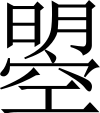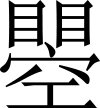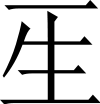Chinese characters of Empress Wu
Chinese characters of Empress Wu, or the Zetian characters (Chinese: 則天文字; pinyin: Zétiān wénzì), are Chinese characters introduced by Empress Wu Zetian, the only reigning female in the history of China, to demonstrate her power. The characters were not created by the Empress herself, but were suggested by an official named Zong Qinke, the son of one of her cousins, in December 689 AD. The number of characters varies between 12, 17, 19, or 30 characters. They were forcibly used by people during her reign but fell into disuse immediately after her death, so they help to determine dates of printed materials.
A few of the surviving characters are preserved in the written histories of Wu Zetian, and a few have found themselves incorporated into modern-day computer standards, classified as either variant or dialect-specific characters.
The form of the characters varies depending on where they are printed. For instance Empress Wu's own name zhào 照 was replaced with 瞾, but is erroneously thought to be 曌, and looking in the Kangxi Dictionary, one finds the description of the former having two 目 ("eye") characters being the proper character rather than the word míng 明 meaning "bright". Another form replaces the 明 above 空 with two 日 characters.
History
Wu was China's only female emperor, and she exercised her power by introducing many reforms. In addition to changing the way people dressed, she wanted to change the words people used.
Empress Wu's written reforms resulted in new characters, which were not created from scratch, but borrowed elements of older characters.
When the Wu dynasty ended, the original words were recovered because people eventually forgot how to write the characters themselves. Some of the characters ended up being preserved in other countries.
Anecdotes about the reign of the Empress Wu can be read in The Book of the Tang.
Examples
| Original character | Pinyin & meaning | New character | Large version | Unicode | Explanation of meaning |
|---|---|---|---|---|---|
| 照 | zhào (also means "illuminate" and "photograph") | 曌 |  | U+66CC | The empress's name, “照” is here composed of the radicals “日月當空/日月当空”, or "the sun and the moon in the sky above". The moon and sun symbolize a harmony of yin and yang. |
| 照 | zhào | 瞾 |  | U+77BE | The way the first character is sometimes written, as appeared in the Kangxi dictionary. Some believe this version came about as a result of Naming taboo. |
| 天 | tiān sky, heaven | 𠑺 |  | U+2047A | This character is based on the seal-script version of 天. |
| 天 | 𠀑 |  | U+20011 | Version of the above character in which some lines are connected, as in handwritten script. | |
| 地 | dì earth | 埊 |  | U+57CA | The character for 'earth' is composed of a mountain, a water, and earth. |
| 日 | rì sun, day | 𡆠 |  | U+211A0 | Said to represent the Three-legged crow Sun deity of Chinese mythology |
| 月 | yuè moon, month | 囝 |  | U+56DD | Said to represent the rabbit or toad-shaped moon. |
| 月 | 𠥱 |  | U+20971 | Also said to represent the rabbit or toad-shaped moon. | |
| 星 | xīng star | 〇 |  | U+3007 | An empty circle, used to represent the word for 'star', now used in Modern Chinese as a Chinese numeral, representing number zero. |
| 人 | rén human, people | 𤯔 |  | U+24BD4 | Consisting of the Chinese numeral "one" (一) above the character for "life" (生), the character carries a meaning that everyone only lives once. |
See also
External links
- More detailed information on these characters (archive link)